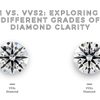
Understanding VVS Diamonds: A Comprehensive Guide
Table Of Contents
- Introduction
- Explaining Diamond Clarity
- Flawless (FL) and Internally Flawless (IF)
- Very, Very Slightly Included (VVS)
- Slightly Included (SI)
- Included
- VVS Simulated Diamonds vs. Natural VVS Diamonds
- Understanding VVS Diamonds
- Benefits of VVS Diamonds
- Drawbacks and Considerations of VVS Lab Diamonds
- Caring for VVS Diamonds
- Conclusion
- FAQS
Introduction
Hello, dear readers! Whether you're an engagement ring planner, a wedding aficionado, or simply an anniversary gift lover, you've probably come across the term "VVS diamonds" once or twice. Or maybe you're just starting on this glittering journey. Either way, I'm here to shed some light on these mesmerizing stones. Let’s delve into the scintillating world of diamond clarity and especially understand the charm of VVS diamonds.
Explaining Diamond Clarity

Before diving into the specifics of VVS diamonds, it's essential to grasp the broader topic of diamond clarity. After all, clarity is one of the four critical Cs (along with cut, carat, and color) that determine a diamond's value and appeal.
Flawless (FL) and Internally Flawless (IF)
These diamonds are the crème de la crème of clarity. FL diamonds have no inclusions or blemishes visible under 10x magnification, making them extremely rare and precious. IF diamonds, on the other hand, might have slight blemishes on the surface but are free of inclusions. Think of them as the nearly perfect siblings of the diamond family.
Very, Very Slightly Included (VVS)
Here's where our primary keyword, VVS diamonds, comes into play. These stones have minuscule inclusions, so tiny that even trained gemologists struggle to find them under 10x magnification. There are two types in this category: VVS1 and VVS2. The former has inclusions only on the bottom or pavilion, while the latter might have them near the top or table. But in practical terms, for someone looking at the diamond without a magnifying glass, it's nearly perfect. When it comes to VVS clarity, you're getting a diamond that's not just beautiful but also offers excellent value.
Slightly Included (SI)
SI diamonds have inclusions that are noticeable under 10x magnification. While these might be visible to the naked eye in some cases, many SI diamonds still offer a brilliant sparkle and come at a significantly reduced price compared to the higher clarity grades.
Included (I)
Lastly, I-grade diamonds have inclusions and/or blemishes that are typically visible without magnification. But don’t dismiss them just yet! These diamonds can still be gorgeous, especially when set in certain jewelry types where the inclusions can be strategically hidden.
VVS Simulated Diamonds vs. Natural VVS Diamonds
A quick detour to address a common question: What about VVS simulated diamonds? Well, these are lab-grown diamonds with VVS clarity. They offer the same physical, chemical, and optical characteristics as natural diamonds. The main difference? They're more environmentally friendly and often more affordable. If you're looking for the sparkle of VVS clarity without the hefty price tag, simulated diamonds might be your best friend.
Understanding VVS Diamonds
When delving into the specifics of diamonds, the term "VVS" may pop up frequently. But what exactly does it mean?
- Definition:
VVS stands for "Very Very Slightly Included". This refers to the clarity grade of the diamond. Clarity, for those new to the world of diamonds, is a measure of the internal and external imperfections, known as inclusions and blemishes, respectively. VVS diamonds have minuscule inclusions that are difficult, even for trained gemologists, to see under 10x magnification.
- How does it differ from other clarity grades?
Diamonds come in various clarity grades ranging from 'Flawless' to 'Included'. VVS diamonds sit close to the 'Flawless' category. They're a notch below the absolute perfection of a Flawless diamond but still offer an incredible clarity that's hard to rival.
Benefits of VVS Diamonds
Choosing a VVS diamond is not just about the prestige; it’s about the tangible and intangible benefits these gemstones bring to the table.
- Exceptional Brilliance:
The near absence of inclusions ensures that the diamond reflects light superbly, resulting in a sparkle that can leave anyone mesmerized.
- Investment Worth Making:
While VVS diamonds command a premium price, they are a worthy investment. Their rarity and demand ensure that they retain their value over time.
- Perfect for Significant Moments:
Given their exceptional clarity, VVS diamonds make for an impeccable choice for engagement rings, anniversary gifts, or any significant life event. They symbolize purity, making your gesture all the more special.
- The allure of the 'almost flawless':
For those who seek something close to perfection but with a slightly more accessible price point than flawless diamonds, VVS is the ideal choice. Plus, the inclusions in VVS diamonds are so tiny that they're almost indistinguishable, giving you the allure of the almost flawless.
Drawbacks and Considerations of VVS Lab Diamonds
Lab-grown VVS diamonds might seem like the perfect choice, given their clarity and the technology-driven approach behind their creation. However, just like any other product, they have their pros and cons.
Perception and Value: Despite being virtually identical to natural diamonds, some traditionalists believe that lab-grown diamonds lack the "romance" or "natural aura" associated with earth-mined diamonds. This might affect the resale value, though the gap is steadily narrowing as lab diamonds gain acceptance.
Limited History: Unlike natural diamonds, which have been mined and traded for centuries, lab diamonds have a shorter history. This might make it challenging for those who love stories of deep-time and geological processes behind their gemstones.
Market Fluctuations: As the technology for creating lab diamonds advances and becomes more common, the market dynamics might shift, leading to potential price volatility.
That said, the beauty and quality of VVS lab diamonds often outweigh these considerations for many. Especially when considering their ethical and environmental benefits.
Caring for VVS Diamonds
Whether it's an engagement ring that's worn daily or a special anniversary necklace, taking care of your VVS lab diamonds is crucial to ensure they remain as dazzling as the day you first laid eyes on them.
Regular Cleaning: Dust, grime, and oils from our skin can accumulate on the surface of diamonds, making them appear dull. Use warm water, a drop of mild detergent, and a soft brush to gently clean your diamond. Rinse with lukewarm water and pat dry with a lint-free cloth.
Avoid Harsh Chemicals: Always remove your diamond jewelry when working with harsh chemicals, including cleaning products or when swimming in chlorinated pools.
Professional Check-ups: At least once a year, take your diamond jewelry to a professional to ensure the settings are secure, and the diamond remains in top condition. They'll also give it a professional clean, ensuring maximum sparkle.
Safe Storage: When not wearing your VVS lab diamonds, store them separately from other jewelry items to avoid scratches. A fabric-lined jewelry box or individual pouches are perfect for this purpose.
Conclusion
Diamond clarity, with its varying degrees from FL to I, offers something for everyone. VVS diamonds, nestled comfortably near the top of the clarity ladder, strike a fantastic balance between sheer beauty and value for money. Whether you opt for a natural VVS diamond or explore the world of VVS simulated diamonds, you're choosing a stone that promises brilliance and fire.
FAQS
What exactly are VVS Diamonds?
VVS diamonds are nearly perfect diamonds with very, very slight inclusions. These inclusions are so minuscule that they're hard to see even under 10x magnification! When you're looking for exceptional clarity in a diamond, VVS is a category that tops the list.
How do VVS Diamonds differ from other clarity grades?
There's a whole spectrum of clarity grades, ranging from Included to Flawless. VVS sits near the pinnacle, with only 'Flawless' and 'Internally Flawless' diamonds ranking higher in terms of clarity.
I've heard about VVS Simulated Diamonds. Are they the same as natural VVS Diamonds?
Not quite. VVS simulated diamonds are stones that mimic the appearance of a VVS clarity diamond but are not made of carbon. They might look close to the real deal but don't possess the same physical and chemical properties.
How do Flawless VVS Simulated Diamonds differ from regular VVS Simulated Diamonds?
Flawless VVS simulated diamonds have zero inclusions or blemishes, even under magnification, making them the pinnacle of simulated diamond perfection. Regular VVS simulated diamonds might have the smallest of inclusions, but they're nearly impossible to spot.
Why might someone choose VVS Lab Diamonds over natural ones?
VVS lab diamonds share the same physical, chemical, and optical properties as mined diamonds. Many opt for them due to their ethical sourcing, often better price points, and guaranteed clarity.
What's the difference between VVS Lab Diamonds and VVS Simulated Diamonds?
The primary difference lies in their composition. VVS lab diamonds are genuine diamonds created in a controlled environment, while VVS simulated diamonds are diamond look-alikes, like cubic zirconia or moissanite.
How do I care for my VVS Diamond jewelry?
Treat it like the precious gem it is! Regularly clean it with a soft brush, lukewarm water, and mild soap. Avoid harsh chemicals and high heat, and consider an annual check-up with a jeweler to ensure prongs and settings remain secure.
Is it worth investing in VVS Diamonds?
Absolutely! For those who value high clarity in their gemstones, VVS diamonds are a top choice. They not only look stunning but also hold their value well over time.
How does VVS clarity impact the overall look and sparkle of a diamond?
VVS clarity ensures that there are minimal internal and external imperfections. This means maximum light reflection and, consequently, a brilliant sparkle that's hard to match.
Any tips for someone shopping for VVS Diamonds?
Always ensure your diamond comes with a certification from a reputable lab. This verifies its quality and authenticity. And remember, while clarity is crucial, also consider the diamond's cut, color, and carat weight to find the perfect gem for you.
Leave a comment
Please note, comments must be approved before they are published.










